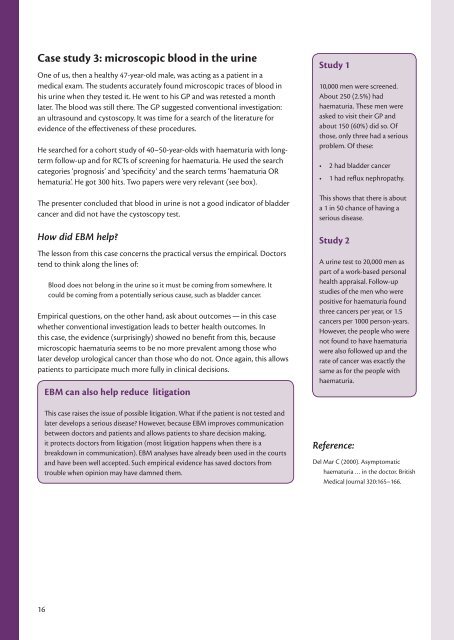Evidence-based Medicine Workbook - Simorgh Research Repository
Evidence-based Medicine Workbook - Simorgh Research Repository
Evidence-based Medicine Workbook - Simorgh Research Repository
You also want an ePaper? Increase the reach of your titles
YUMPU automatically turns print PDFs into web optimized ePapers that Google loves.
Case study 3: microscopic blood in the urine<br />
One of us, then a healthy 47-year-old male, was acting as a patient in a<br />
medical exam. The students accurately found microscopic traces of blood in<br />
his urine when they tested it. He went to his GP and was retested a month<br />
later. The blood was still there. The GP suggested conventional investigation:<br />
an ultrasound and cystoscopy. It was time for a search of the literature for<br />
evidence of the effectiveness of these procedures.<br />
He searched for a cohort study of 40–50-year-olds with haematuria with longterm<br />
follow-up and for RCTs of screening for haematuria. He used the search<br />
categories ‘prognosis’ and ‘specificity’ and the search terms ‘haematuria OR<br />
hematuria’. He got 300 hits. Two papers were very relevant (see box).<br />
The presenter concluded that blood in urine is not a good indicator of bladder<br />
cancer and did not have the cystoscopy test.<br />
How did EBM help<br />
The lesson from this case concerns the practical versus the empirical. Doctors<br />
tend to think along the lines of:<br />
Blood does not belong in the urine so it must be coming from somewhere. It<br />
could be coming from a potentially serious cause, such as bladder cancer.<br />
Empirical questions, on the other hand, ask about outcomes — in this case<br />
whether conventional investigation leads to better health outcomes. In<br />
this case, the evidence (surprisingly) showed no benefit from this, because<br />
microscopic haematuria seems to be no more prevalent among those who<br />
later develop urological cancer than those who do not. Once again, this allows<br />
patients to participate much more fully in clinical decisions.<br />
EBM can also help reduce litigation<br />
This case raises the issue of possible litigation. What if the patient is not tested and<br />
later develops a serious disease However, because EBM improves communication<br />
between doctors and patients and allows patients to share decision making,<br />
it protects doctors from litigation (most litigation happens when there is a<br />
breakdown in communication). EBM analyses have already been used in the courts<br />
and have been well accepted. Such empirical evidence has saved doctors from<br />
trouble when opinion may have damned them.<br />
Study 1<br />
10,000 men were screened.<br />
About 250 (2.5%) had<br />
haematuria. These men were<br />
asked to visit their GP and<br />
about 150 (60%) did so. Of<br />
those, only three had a serious<br />
problem. Of these:<br />
• 2 had bladder cancer<br />
• 1 had reflux nephropathy.<br />
This shows that there is about<br />
a 1 in 50 chance of having a<br />
serious disease.<br />
Study 2<br />
A urine test to 20,000 men as<br />
part of a work-<strong>based</strong> personal<br />
health appraisal. Follow-up<br />
studies of the men who were<br />
positive for haematuria found<br />
three cancers per year, or 1.5<br />
cancers per 1000 person-years.<br />
However, the people who were<br />
not found to have haematuria<br />
were also followed up and the<br />
rate of cancer was exactly the<br />
same as for the people with<br />
haematuria.<br />
Reference:<br />
Del Mar C (2000). Asymptomatic<br />
haematuria … in the doctor. British<br />
Medical Journal 320:165–166.<br />
16










